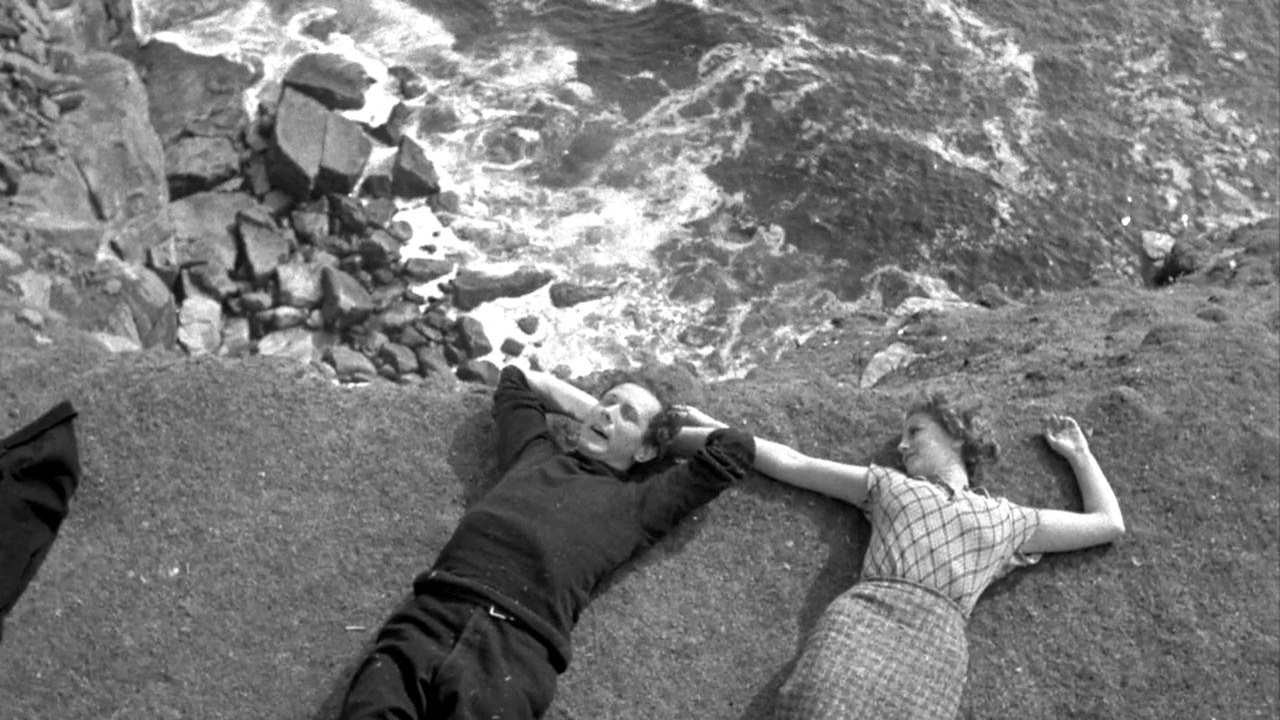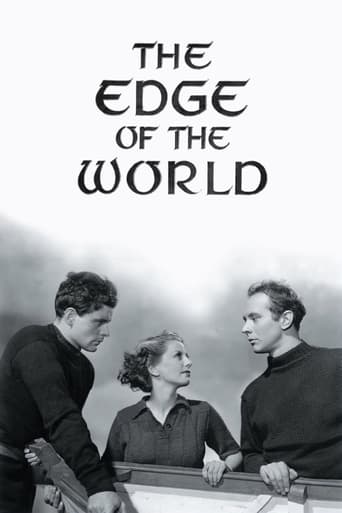



Fantastic!
Excellent and certainly provocative... If nothing else, the film is a real conversation starter.
View MoreTrue to its essence, the characters remain on the same line and manage to entertain the viewer, each highlighting their own distinctive qualities or touches.
View MoreStrong acting helps the film overcome an uncertain premise and create characters that hold our attention absolutely.
View MoreMichael Powell is best known for the films he made with Emeric Pressburger under the brand name "The Archers", but "The Edge of the World" from 1937 is a solo project, predating his partnership with Pressburger. It was inspired by the evacuation of the remote Scottish archipelago of St Kilda in 1930. Here the island is named "Hirta", which is the same name as that of the main island of the St Kilda group, but it is relocated from the Hebrides to the Orkneys or Shetlands. (Permission to film on St Kilda itself was refused, so filming actually took place on Foula in the Shetlands, although that island was, and remains to this day, inhabited).A wealthy young couple, sailing around Scotland by yacht, arrive on the island where they discover abandoned cottages but no human inhabitants. They ask Andrew Gray, the skipper of their yacht and himself a native of the island, what happened, and he explains that the island has been deserted for ten years. He then tells them the story of how the population came to leave. The islanders were divided among themselves; some, including Andrew himself, wanted to stay whereas others, such as his close friend Robbie Manson, wanted to leave. Even families were split; Andrew's father James sided with Robbie, whereas Robbie's father Peter and his sister Ruth (who was also Andrew's sweetheart) were both among those determined to stay.The story told here is partly based upon the true story of the evacuation of St Kilda and is partly fictitious. As on the real St Kilda, the main factor which is drawing people away from the fictitious island of "Hirta" is the greater employment opportunities offered to young people on the mainland. There is also the fact that there are no medical facilities on the island. The people of Hirta are also concerned that competition from commercial trawlers is damaging the local fishing industry. (This was not a factor on the real St Kilda, where the rough and perilous seas meant that the local people did little fishing). As the younger generation gradually leave, this makes it more difficult for those remaining to follow their traditional way of life which relies on strong, fit young people to help with the fishing and crofting and to gather sea birds' eggs from the cliffs. (This was an important source of protein in their diet). Powell, born in Canterbury, may have been a native of southern England, but had a deep love of the Scottish highlands and islands; two of his later films with Pressburger, "The Spy in Black" and "I Know Where I'm Going!" were also set in the area. "The Edge of the World" can be seen as his tribute to the way of life of the local people, a life which Powell and his cast and crew shared for several months while on Foula. (No air service or regular ferry existed in 1937, meaning that they had to stay on the island for the whole length of the shoot).While "The Edge of the World" tells a fictional story, it has a documentary feel to it, reminiscent of the documentary shorts such as "The Islanders" which were being produced by the GPO Film Unit around the same time. At this period life on remote islands was hard and lonely; the islanders of Foula, like those of St Kilda, had no gas, electricity or running water. They had never seen a car, an aircraft or even a bicycle. There were no radios and no postal service; their only way of communicating with the outside world was to launch a letter into the sea in a small wooden vessel, hoping it would be picked up by a passing ship. (They make use of this method during the film). The characters in the film refer to the mainland as "Scotland", as through Scotland were somewhere foreign, not the country where they live.Powell shows us not only the hardships and dangers of their life but also their simple religious faith, their democratic ways (all decisions of importance are taken by an island Parliament) and their independent spirit. He also captures, in some striking black- and-white photography, the austere natural beauty of the island. The film may not have the complexity of some of his "Archers" films, but it has a beauty, a tragic power and a poetic simplicity which make it unusual in the annals of British film-making, matched in these respects perhaps only by Bryan Forbes' "Whistle Down the Wind". 9/10A goof. The main story is said to have happened ten years ago, presumably in 1927, but the characters refer to the evacuation of St Kilda, which did not occur until 1930.
View MoreWhat's it like to live on a treeless rock in the middle of the roiling north Atlantic. We get a pretty good idea from master film-maker Michael Powell who set up his camera in such a place with a few actors, a scant script, and actual residents as extras. And a heck-of-a movie it is. The result looks like something from the neolithic era, with its crude rock huts, long barren vistas, and a few hunkered-down plants, along with jagged cliffs rising out of the sea like the face of God. One thing for sure -- there's no lack of fresh air .I can't imagine the movie was made for commercial potential. It resembles Robert Flaherty's gripping documentary of life in the Irish Sea, Man of Aran, which may be why Powell distinguished his effort with a story-line. But the visuals are quite similar. And that's fine, because the craggy vistas are unforgettable. This is close to movie making at its purest and most visual. In fact, on another viewing, I think I'll turn off the sound and simply gasp at the other-world imagery.The story may be secondary, but it's appropriate. The few remaining islanders are leaving after centuries of habitation because of deteriorating conditions. There's a romantic complication, but thankfully it doesn't get in the way. A few scenes etch themselves in my memory-- the sheep dogs lined-up outside the crude church, the tiny mail-carrying boats tossed into the sea like wishes, but most of all, the overawing sea cliffs, endless in their poetry and power. It's got to be here that the earth meets the sky or whatever it is that's above.Rather hard for me to believe that this spartan black and white was made by the same artist who made the splashy Technicolors of The Red Shoes and Peeping Tom. But Powell excelled at cinema regardless of format, putting him in the same league as the few other British masters like Alfred Hitchcock. But whatever the pedigree, this 80 minutes of air, rock and water remains a really compelling oddity.
View More'The Edge of the World' presents the story of the death of an island, St Kilda (although filmed on Foula due to access restrictions), through the eyes of the two main families living there.The Grays look for progress and to the mainland for survival, while the Mansons nurture the old way of life. But do their children feel the same way? Evocative, groundbreaking in its construction (using camera tricks and the natural scenery to create its spell), and containing a number of fine performances, not least from John Laurie and Finlay Currie as the rival family heads, and Niall McGinnis as the Gray son, impatient to marry and escape the slowly shrinking community, 'The Edge of the World' is a special film.Short on plot, slow-moving, and strong on atmosphere, this film gives a taster of what would come in later Powell-Pressburger efforts such as 'A Canterbury Tale' and especially 'I Know Where I'm Going!'
View MoreMichael Powell, the distinguished English director, was a man of vision. He takes us on a voyage to a remote place in order to set his drama about what the inhabitants of the mythical Hirta, in the Hebrides, were going through. The film was actually filmed in Fulla, in the Shetland Islands, which resembles its model. The original island of St. Kilda had been deemed the last place on earth as the Romans sailed the area and since the island resembles a wall rising from the sea, it must have appeared that way to those explorers. Mr. Powell was lucky in working with the producer Joe Rock, whose generosity made this early film worth discovering.The film opens with a shot of the island from the sea. We see the island rise from the water, as the Romans might have seen it. Little has changed in the place, except now it's deserted. The people of the island have long gone over the mainland because it was hard for them to make a living in that barren and inhospitable place. The island is now a bird sanctuary. The yacht is commandeered by Andrew Gray, who has left the place and now his memories of that turbulent past come back to him.We go back in a flashback to know what happened in the island some time ago. We see the Manson family as they prepare for church. Peter, the patriarch, has two children, Ruth and Robbie. Andrew Gray is in love with the beautiful Ruth. Later in a competition to get to the top of the highest spot in the island Robbie suffers a tragic accident. Andrew decides to leave for the main land with his father's blessings, but Ruth is left with child, not knowing how to contact Andrew. When the whole population decides to leave, Peter Manson, reluctantly agrees, but tragedy intervenes when a terrible accident occurs.The acting is magnificent. John Laurie is seen as Peter Manson, the man whose love for the land is his passion. Belle Chrystall plays Ruth the gorgeous island girl in love with Andrew. Eric Berry and Niall MacGinnis are Robbie and Andrew and Finlay Currie makes James Gray come alive."The Edge of the World" shows a Michael Powell in great form. Mr. Powell must have taken a tremendous chance by even filming in that remote place, but he is rewarded by a timeless film that will live forever.
View More